Reduce eye wrinkles and improve skin elasticity with VERISOL®P
Reduce eye wrinkles and improve skin elasticity with VERISOL®P
When we are in our 20s, the amount of collagen that our bodies produce can start to decline2 at an estimated rate of 1% in our skin every year3-4. This means that our skin cell structure starts to weaken which results in visible signs of ageing such as wrinkles, dryness and loss of shape to our skin10.
Collagen is vital for skin elasticity. It can be greatly affected by endogenous and environmental factors such as ageing2-5, UV radiation6 , pollution7, smoking8 and poor nutrition9.
Recently collagen peptides have gained a reputation for their ability to positively influence human collagen metabolism11-13.

What is VERISOL®P?
VERISOL®P is made up of pure, natural collagen peptides that have been specifically developed and scientifically proven to provide the highest possible efficacy in human skin, with results showing as soon as after 4 weeks14,16.
Collagen peptides work by stimulating our skin’s metabolism from within16. Consumers who ingest VERISOL®P, can experience noticeably smoother skin 14,15 with a reduction in the depth of their eye wrinkles16 and improved skin elasticity14.
Other positive effects of VERISOL®P include improvements in skin surface structure, a reduction in cellulite15 and faster nail growth with consumers saying that their fingernails were chipping less17.
When taken regularly, VERISOL®P collagen peptides can visibly reduce the depth of eye wrinkles 16 and improve skin elasticity14 , as skin starts to gain tone and firmness. This effect cannot be achieved with any topical skin care product because they can only reach the outer layers of the skin18 – even the effects of the most expensive face creams are short-lived.
There are 3 prominent types of Collagen: I, II and III1. Collagen I and III are the main collagen types located in the skin1. Collagen II is mainly the basis of cartilage2, which makes joints easier to move.
Verisol®P has been derived from peptides obtained from type I and III Collagen3,5.
clean label
highly digestible food
non-allergenic protein
scientific evidence
The Benefits
Some of the key benefits noticed after 4 weeks of consuming Verisol®P were:
![]() Improvements in skin elasticity14
Improvements in skin elasticity14
![]() Reduction16 in wrinkles
Reduction16 in wrinkles
![]() Delays in the visible signs of skin ageing14,16
Delays in the visible signs of skin ageing14,16
![]() Reduction in visible signs of cellulite after 3 months
Reduction in visible signs of cellulite after 3 months
How do collagen peptides manage to achieve all of the above? To better understand collagen and how we can reap its benefits, we need to look at it under the microscope as a molecule.
Natural collagen is made up of chains that each contain around 1000 amino acids. These chains wind around each other like a spiral to form a triple helix19. This solid structure is what makes collagen a strong, secure and flexible protein19.
Our body naturally produces collagen, but over time, our metabolism becomes weary and collagen production starts to slow down. When we think about skin ageing, many of us think that it happens later in life. However, the process starts much earlier than we think and is well-established by our mid-late 20s2,21.
After the age of 45, these changes to our skin speed up. A study found that in the first 15-18 years after the menopause, collagen in skin starts to decline by 2.1% a year, while the thickness of our skin can reduce at an average rate of 1.13% per year28.
Skin ageing, in our faces, is caused by a reduction in skin elasticity. It’s thought that skin elasticity declines by 0.55% per year during our fifties30, which results in the quality of our skin deteriorating and increased wrinkles.
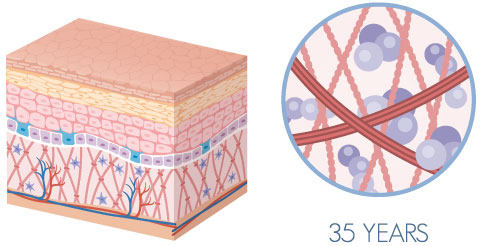
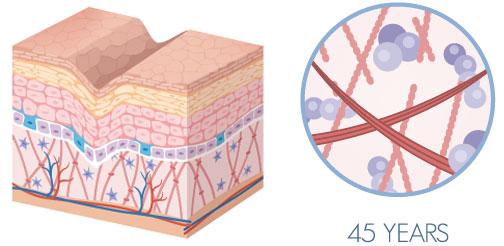
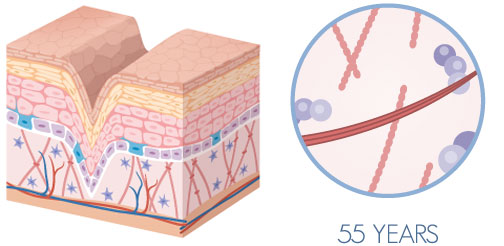
VERISOL® P – optimized for skin improvement, can increase skin elasticity and reduce wrinkles in only 4 weeks.
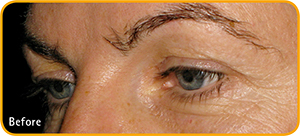
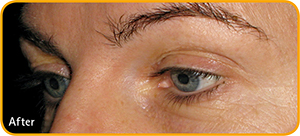
Move the slider from right to left to see Before and After results
Scientifically Proven
- Numerous clinical trials investigated the potential of VERISOL®P .
- Double-blind, randomized placebo-controlled studies (from 2011 to 2015) with a total of 288 participants studied the benefits of VERISOL®P supplementation on skin.
1. Study: Higher skin elasticity
A study with 69 women aged between 35 and 55 years revealed that VERISOL® P leads to significantly higher skin elasticity compared to placebo treatment. This effect could be measured after just 4 weeks of treatment and persisted after 8 weeks of VERISOL® P supplementation. Another 4 weeks after the last intake of the product, the VERISOL® P group still showed higher skin elasticity levels compared to the placebo group.

2. Study: Reduction of wrinkles
The oral administration of VERISOL®P (2.5 g/day) significantly reduces wrinkles starting after 4 weeks and leads to a significantly higher skin procollagen formation.

3. Study: Improved skin surface structure and reduced cellulite
VERISOL®P supplementation has beneficial effects on the dermal extracellular matrix of the skin and can help to decrease cellulite. Contrary to current cellulite supplements that mainly address the aspects of excessive fat or microcirculation/ drainage, VERISOL® P directly stimulates the extracellular matrix formation in the skin.
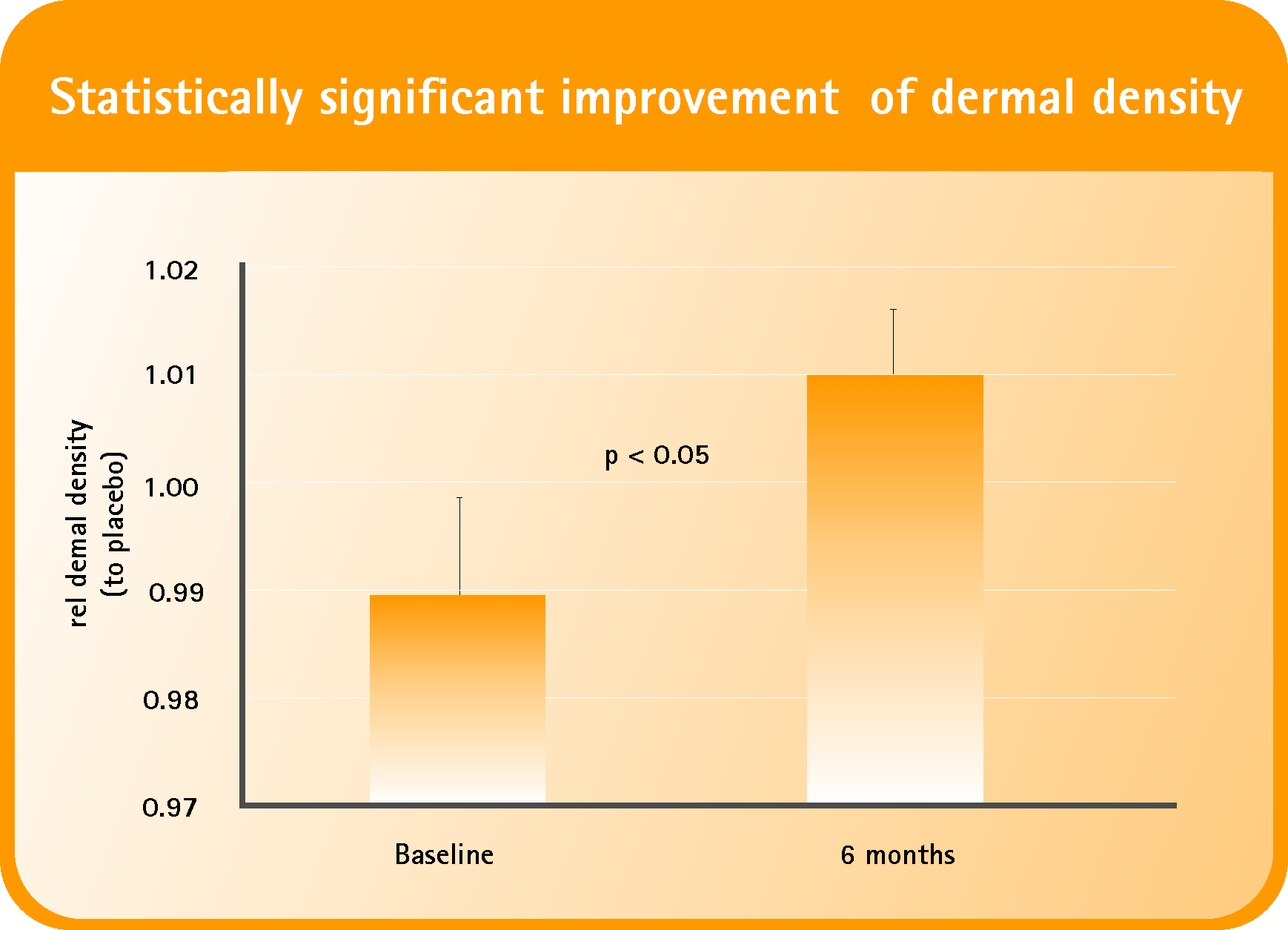
References
1. Brett D. A Review of Collagen and Collagen-based Wound Dressings. Wounds. 2008 Dec;20(12):347-56.
2. Kehlet SN et al. Age-related collagen turnover of the interstitial matrix and basement membrane: Implications of age- and sex-dependent remodelling of the extracellular matrix. PLoS One. 2018 Mar 29;13(3): e0194458
3. Shuster, S., Black, M. M. & McVitie, E. The influence of age and sex on skin thickness, skin collagen and density. Br J Dermatol. 6, 639–643 (1975).
4. Edgar S et al. Effects of collagen-derived bioactive peptides and natural antioxidant compounds on proliferation and matrix protein synthesis by cultured normal human dermal fibroblasts. Sci Rep. 2018 Jul 11;8(1):10474.
5. Stevenson S and Thornton J. Effect of estrogens on skin aging and the potential role of SERMs. Clin Interv Aging. 2007 Sep; 2(3): 283–297.
6. Jariashvili K, Madhan B, Brodsky B, Kuchava A, Namicheishvili L, Metreveli N. UV damage of collagen: insights from model collagen peptides. Biopolymers. 2012;97(3):189-98
7. Park SY et al. Air Pollution, Autophagy, and Skin Aging: Impact of Particulate Matter (PM 10) on Human Dermal Fibroblasts. Int J Mol Sci. 2018 Sep 12;19(9):2727
8. Knuutinen A, Kokkonen N, Risteli J, Vahakangas K, Kallioinen M, Salo T, et al. Smoking affects collagen synthesis and extracellular matrix turnover in human skin. The British journal of dermatology. 2002;146(4):588-94.
9. Danby FW. Nutrition and aging skin: sugar and glycation. Clinics in dermatology. 2010;28(4):409-11.
10. Jenkins G. Molecular mechanisms of skin ageing. Mech Ageing Dev. 2002 Apr;123(7):801-10
11. Iwai K, Hasegawa T, Taguchi Y, Morimatsu F, Sato K, et al. (2005) Identification of food-derived collagen peptides in human blood after oral ingestion of gelatin hydrolysates. J Agric Food Chem 53: 6531-6536.
12. Ichikawa S, Morifuji M, Ohara H, Matsumoto H, Takeuchi Y, et al. (2010) Hydroxyproline-containing dipeptides and tripeptides quantified at high concentration in human blood after oral administration of gelatin hydrolysate. Int J Food Sci Nutr 61: 52-60.
13. Ohara H, Ichikawa S, Matsumoto H, Akiyama M, Fujimoto N, Kobayashi T, et al. Collagen-derived dipeptide, proline-hydroxyproline, stimulates cell proliferation and hyaluronic acid synthesis in cultured human dermal fibroblasts. The Journal of dermatology. 2010;37(4):330-8.
14. Proksch E, Segger D, Degwert J, Schunck M, Zague V, Oesser S. Oral supplementation of specific collagen peptides has beneficial effects on human skin physiology: a double-blind, placebo-controlled study. Skin pharmacology and physiology. 2014;27(1):47-55
15. Schunck M, Zague V, Oesser S, Proksch E. Dietary Supplementation with Specific Collagen Peptides Has a Body Mass Index-Dependent Beneficial Effect on Cellulite Morphology. Journal of medicinal food. 2015;18(12):1340-8
16. Proksch E, Schunck M, Zague V, Segger D, Degwert J, Oesser S. Oral intake of specific bioactive collagen peptides reduces skin wrinkles and increases dermal matrix synthesis. Skin pharmacology and physiology. 2014;27(3):113-9
17. Hexsel D et al. Oral supplementation with specific bioactive collagen peptides improves nail growth and reduces symptoms of brittle nails. J Cosmet Dermatol. 2017 Dec;16(4):520-526.
18. Aldag C, Nogueira Teixeira D, Leventhal PS. Skin rejuvenation using cosmetic products containing growth factors, cytokines, and matrikines: a review of the literature. Clinical, cosmetic and investigational dermatology. 2016;9:411-9.
19. Shoulders MD and Raines RT. COLLAGEN STRUCTURE AND STABILITY. Annu Rev Biochem. 2009; 78: 929–958.
20. Danby FW. Nutrition and aging skin: sugar and glycation. Clin Dermatol. Jul-Aug 2010;28(4):409-11.
21. Corstjens H. et al. Glycation associated skin autofluorescence and skin elasticity are related to chronological age and body mass index of healthy subjects. Exp Gerontol. 2008 Jul;43(7):663-7
22. Nguyen HP and Katta R. Sugar Sag: Glycation and the Role of Diet in Aging Skin. Skin Therapy Lett
. 2015 Nov;20(6):1-5.
23. Yamauchi M et al. Collagen cross-linking in sun-exposed and unexposed sites of aged human skin. J Invest Dermatol. 1991 Nov;97(5):938-41
24. Fisher GJ et al. Looking older: fibroblast collapse and therapeutic implications. Arch Dermatol. 2008 May;144(5):666-72
25. Potts RO et al. Changes with age in the moisture content of human skin. J Invest Dermatol. 1984 Jan;82(1):97-100.
26. Gunin AG et al. Age-related changes of blood vessels in the human dermis. Adv Gerontol. 5, pages65–71(2015)
27. Pochi PE, Strauss JS, Downing DT. Age-related changes in sebaceous gland activity. J Invest Dermatol 1979; 73: 108-11.
28. Brincat M, Kabalan S, Studd JWW, et al. A study of the decrease of skin collagen content, skin thickness, and bone mass in the postmenopausal women. Obstet Gynecol 1987; 70: 840-5
29. Harvell J et al. Changes in transepidermal water loss and cutaneous blood flow during the menstrual cycle. Contact Dermatitis. 1992 Nov;27(5):294-301
30. Sumino H. et al. Effects of aging, menopause, and hormone replacement therapy on forearm skin elasticity in women. J Am Geriatr Soc. 2004 Jun;52(6):945-9.
